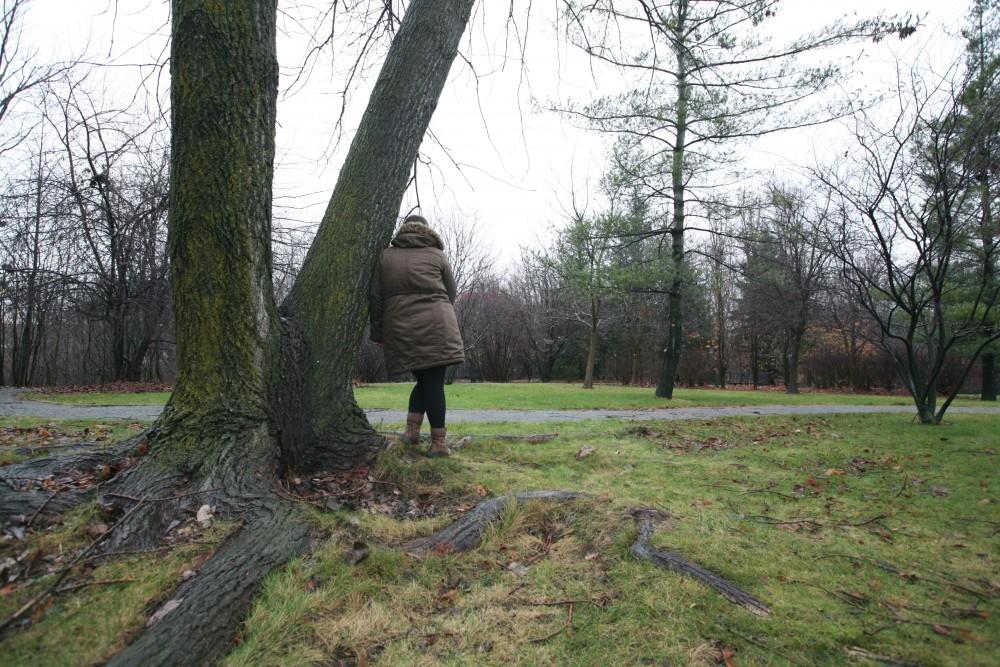SAD in season

Dale Carnegie, eat your heart out. GVL Archives
Nov 28, 2011
The lack of light can be frustrating, but to get down in the dumps during times of bad weather happens to everyone, said Wayne Kinzie, a licensed psychologist in Grand Valley State University’s Counseling and Career Development Center.
“It’s very normal and very natural to have a sort of low-energy, maybe a depressive kind of reaction, especially when the winter goes on and on and on … and here is February, and March, and it’s still snowing, and it’s still cloudy and we have five days of lake effect snow,” he said. “I say to people at this point of the season, ‘If you’re not somewhat depressed you must be brain dead.’”
Harriet Singleton, a licensed professional counselor in the Counseling and Career Development Center and the coordinator of multicultural counseling and diversity, said a main indicator of if depressive symptoms are serious is if they interfere with daily life. For those people whose daily lives are affected by depressive symptoms that occur seasonally, it could be seasonal affective disorder, also referred to as seasonal depression, which is a form of depression.
According to WebMD, “researchers agree that people who suffer from seasonal affective disorder are particularly sensitive to light, or the lack of it.”
‘It’s cyclical’
A main characteristic of SAD is that it reappears each year when there is less natural light and the seasons change, Singleton said.
“It’s cyclical, and for some people it’s almost the same day. It’s like when some people have allergies in the fall,” she said.
Feeling apathetic and tired during the change of seasons is not a weird or abnormal thing, though, Kinzie said, when you think about biology and how so many other animals are hibernating during the dreary winter weather. But hibernating is not an option for most college students, as SAD can pop up right during the crunch time of fall semester.
“We’re going against what our bodies biologically want to do,” he added.
Letting the doctor decide
Although the down-in-the-dumps feelings can affect everyone, they take more of a toll on some, and Singleton said it is important to communicate with a health professional if you think you have any degree of SAD.
“I recommend people don’t self-diagnose,” she said, because her diagnosis criteria could be completely different from a patient’s idea of what is normal.
She said she had a student come see her in April to say he thought he had a mild case of depression, because he had not be able to get out of bed since January. For Singleton, this was a severe case that required more treatment than a patient can provide to himself.
Kinzie said that when is speaking with someone who might have depression, he will specifically ask, “When did you go to bed last night?” “When did you get up this morning?” “Are you missing classes?”
“What I’m after is, is their depression such that it’s really interfering in an important way?” he said. “When the depression starts interfering with the normal, functioning life then we have a problem.”
Natural light and mood lamps
Since SAD is related to a lack of sunlight during the winter, both counselors recommend using light as a therapy to improve mood.
Kinzie said the best way to do this is to get active outdoors, such as playing a sport or simply taking a walk.
“Even on a cloudy day, the sun’s out,” Singleton said.
If you cannot actually get outside, Kinzie said he recommends exercising in the Recreation Center in front of the huge windows that let in sunlight while people work out.
“They designed it exactly right,” he said.
Another non-outdoors option to get more light exposure would be light therapy. The Counseling and Career Development Center has a mood lamp on the Allendale Campus and one on the Pew Campus as well. The mood lamp sits on a table, and a student can simply walk in and ask to use it. The lamp’s instructions say that reading, checking e-mail or eating breakfast are all possible activities, as the only requirement is to sit 11-12 inches away from the light.
“It has been shown to be effective, and I encourage students to use it,” Kinzie said.
According to WebMD, the best time for light therapy is the morning, possibly because it goes along with how sunlight appears in nature.





















